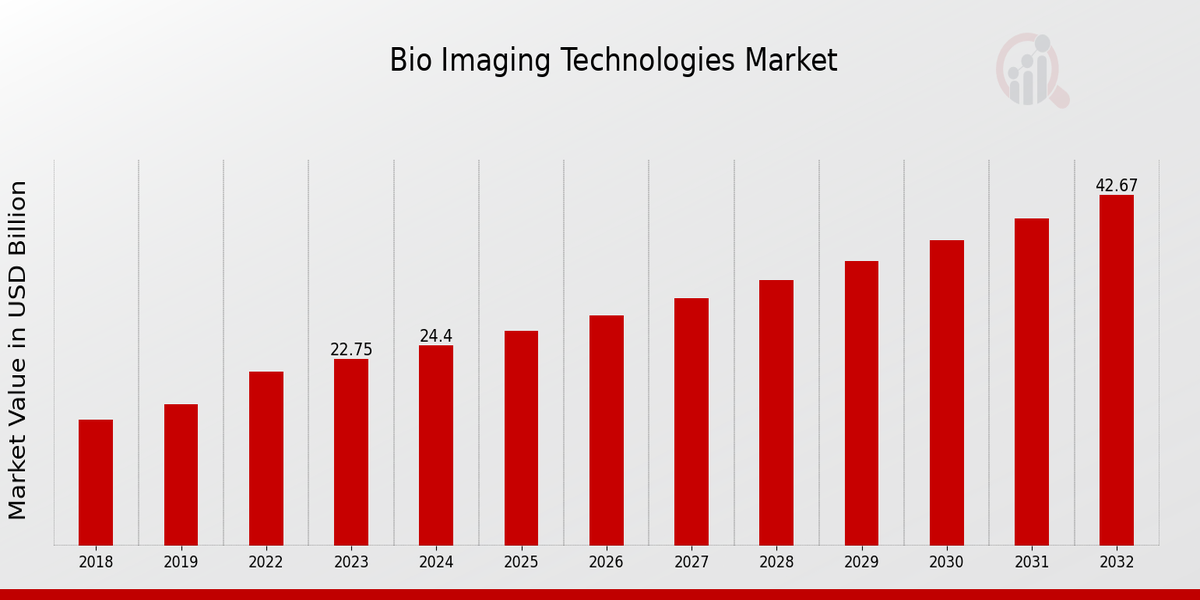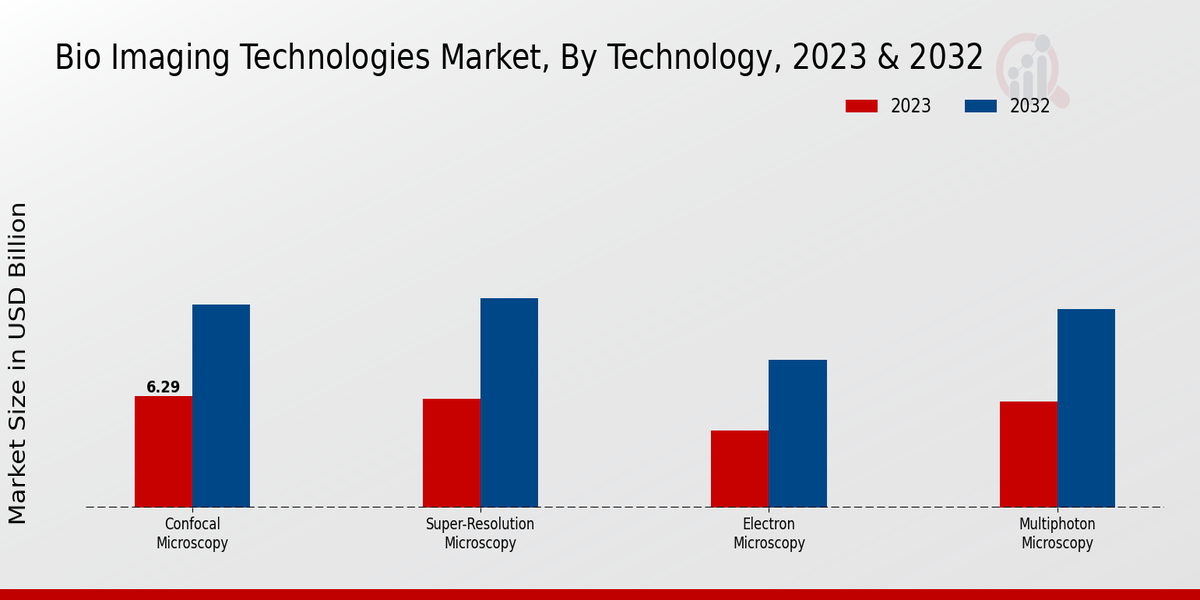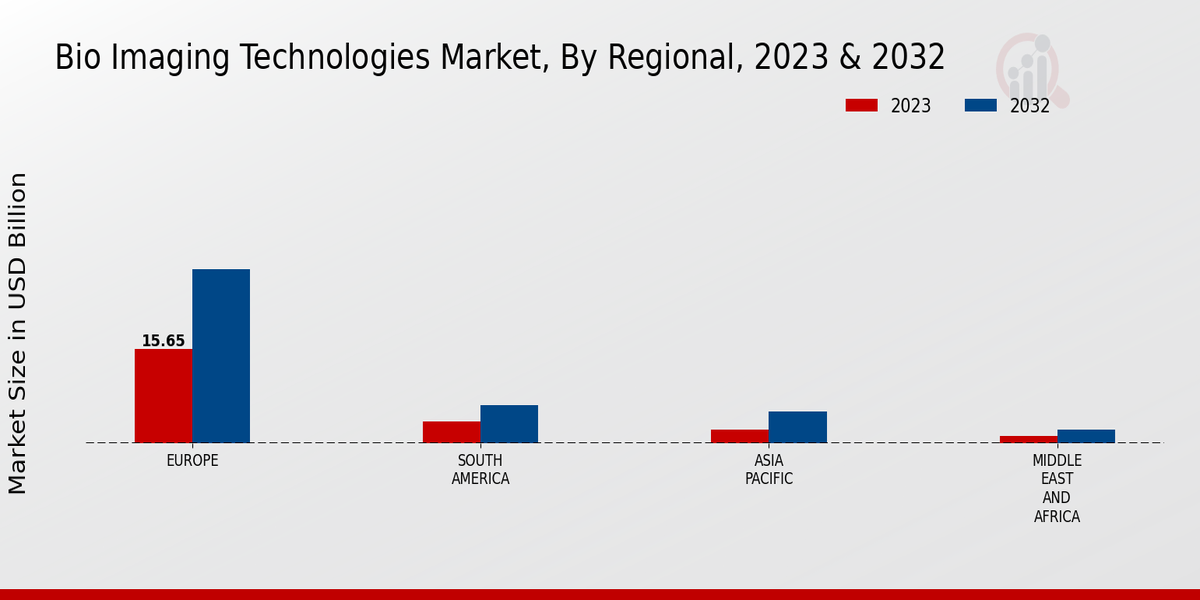Bio Imaging Technologies Market Overview:
As per MRFR analysis, the bio imaging technologies market size was estimated at 5.75 (USD Billion) in 2023. The Global bio imaging technologies market industry is expected to grow from 6.18 (USD Billion) in 2023 to 10.19 (USD Billion) by 2032. The bio imaging technologies market CAGR (growth rate) is expected to be around 5.71% during the forecast period (2024-2032).
Key Bio Imaging Technologies Market Trends Highlighted
The bio imaging technologies market is anticipated to witness significant growth in the coming years, driven by rising demand for early and accurate disease diagnosis, advancements in imaging technologies such as AI, machine learning, and deep learning, and increasing government funding for research and development.
Pharmaceutical and biotechnology companies are embracing bio imaging for drug discovery and development, further contributing to market expansion. The growing prevalence of chronic diseases, increasing awareness about personalized medicine, and technological advancements in microscopy and spectroscopy are key drivers of market growth. Furthermore, emerging applications in fields such as neuroscience and cancer research are creating new opportunities for bio imaging technologies.

Source: Primary Research, Secondary Research, MRFR Database and Analyst Review
Bio Imaging Technologies Market Drivers
Increasing Prevalence of Chronic Diseases
The rising incidence of chronic diseases, such as cancer, cardiovascular diseases, and diabetes, has significantly contributed to the growth of the Bio Imaging Technologies Market. These diseases require early detection and accurate diagnosis, which is driving the demand for advanced bio imaging technologies.
Bio imaging techniques, such as MRI, CT scans, and PET scans, provide detailed anatomical and functional information, aiding in precise diagnosis and personalized treatment plans. The increasing prevalence of chronic diseases is expected to continue fueling the demand for bio imaging technologies in the coming years.
Technological Advancements and Innovation
The bio imaging technologies market has witnessed significant technological advancements in recent years. The development of novel imaging modalities, such as molecular imaging and theranostics, has expanded the applications of bio imaging technologies.
Advancements in artificial intelligence (AI) and machine learning (ML) are also enhancing the accuracy and efficiency of bio imaging techniques. These technological advancements are enabling the development of more precise and personalized diagnostic and therapeutic solutions, driving the growth of the market.
Government Initiatives and Funding
Governments worldwide are recognizing the importance of bio imaging technologies in healthcare and are actively supporting research and development in this field. Funding for bio imaging research has increased significantly in recent years, leading to the development of innovative technologies and applications. Government initiatives, such as precision medicine initiatives and cancer research programs, are also contributing to the growth of the Bio Imaging Technologies Market.
Bio Imaging Technologies Market Segment Insights:
Bio Imaging Technologies Market Technology Insights
The technology segment plays a crucial role in driving the growth of the bio imaging technologies market. Confocal microscopy, super-resolution microscopy, electron microscopy, and multiphoton microscopy are the key technologies shaping the market landscape.
Confocal microscopy is projected to reach USD 3.7 billion by 2026, growing at a CAGR of 8.5% from 2021 to 2026. This growth is attributed to the increasing demand for high-resolution imaging in various biological applications, including cell biology, developmental biology, and neuroscience.
Super-Resolution microscopy is anticipated to witness significant growth in the coming years. This technology enables the visualization of cellular structures at a resolution beyond the diffraction limit of light, providing researchers with unprecedented insights into cellular processes.
Electron microscopy is expected to grow at a steady pace, driven by the advancements in sample preparation techniques and the development of new electron microscopes. This technology offers ultra-high resolution imaging, making it essential for studying the structure and function of biological molecules and materials at the atomic level.
Multiphoton microscopy market is gaining traction due to its ability to perform non-invasive, high-resolution imaging deep within biological tissues. This technology is widely used in neuroscience, developmental biology, and cancer research.
The technology segment of the bio imaging technologies market is highly competitive, with leading players continuously investing in research and development to enhance their offerings. Technological advancements, such as the integration of artificial intelligence and machine learning, are expected to further drive the growth of this segment in the future.

Source: Primary Research, Secondary Research, MRFR Database and Analyst Review
Bio Imaging Technologies Market Application Insights
The bio imaging technologies market is segmented into various applications, including cell biology, neuroscience, developmental biology, and cancer research. Among these, cell biology held the largest market share in 2023 and is projected to continue its dominance throughout the forecast period. The growing demand for bio imaging technologies in cell biology research, such as studying cell structure, function, and dynamics, is driving the growth of this segment.
Neuroscience, with its increasing focus on brain mapping and understanding neurological disorders, is another significant application segment. Developmental biology, which utilizes bio imaging technologies to study embryonic development and organ formation, is also expected to witness substantial growth in the coming years. Cancer research, with its reliance on bio imaging for tumor visualization, diagnosis, and treatment monitoring, is another key application segment contributing to the overall market growth.
Bio Imaging Technologies Market Sample Type Insights
The market is segmented by sample type into live cells, fixed cells, tissues, and three-dimensional (3D) samples. Among these segments, live cells held the largest market share in 2023. The growth of this segment can be attributed to the increasing adoption of live cell imaging techniques in drug discovery and development, as well as in basic research.
The fixed cells segment is expected to witness significant growth over the forecast period, owing to the rising demand for fixed cell imaging in diagnostic applications. The tissues segment is also expected to grow steadily, driven by the increasing use of tissue imaging in cancer research and drug development.
The three-dimensional (3D) samples segment is expected to grow at a rapid pace, due to the increasing adoption of 3D imaging techniques in drug discovery and development.
Bio Imaging Technologies Market End User Insights
The end user segment is categorized into academia, pharmaceutical and biotechnology, medical diagnostics, and industrial. In 2023, the pharmaceutical and biotechnology sector dominated the market with a revenue share of around 45%, owing to the increasing adoption of bio imaging technologies for drug discovery and development.
The medical diagnostics segment is anticipated to exhibit the highest CAGR during the forecast period, driven by the rising demand for personalized medicine and the development of advanced diagnostic techniques.
The academia segment holds a significant market share due to the extensive use of bio imaging technologies in research and development activities. The Industrial segment is projected to witness steady growth, attributed to the adoption of bio imaging technologies for quality control and inspection purposes.
Bio Imaging Technologies Market Regional Insights
North America held the largest share of the bio imaging technologies market in 2023 and is expected to maintain its dominance throughout the forecast period. The growth of the regional market can be attributed to the increasing adoption of advanced imaging technologies by hospitals and research institutions, the presence of many leading bio imaging technology providers, and government initiatives to promote the adoption of innovative healthcare technologies.
Europe is another major market for bio imaging technologies and is expected to continue to grow steadily over the forecast period. The increasing demand for personalized medicine and the growing adoption of minimally invasive procedures are driving the growth of the regional market.
The Asia-Pacific region is expected to witness the highest growth rate over the forecast period, owing to the increasing healthcare expenditure, the rising prevalence of chronic diseases, and the growing awareness of bio imaging technologies. South America and the Middle East and Africa are expected to register moderate growth rates over the forecast period, as the adoption of bio imaging technologies is still in its early stages in these regions.

Source: Primary Research, Secondary Research, MRFR Database and Analyst Review
Bio Imaging Technologies Market Key Players and Competitive Insights:
Major players in the market are continuously investing in research and development to introduce advanced technologies and solutions. Leading market players are focused on strategic collaborations and partnerships to expand their market reach and gain a competitive edge. They are also actively involved in mergers and acquisitions to strengthen their product portfolios and increase their market share.
The bio imaging technologies market development is driven by technological advancements, such as the development of high-resolution imaging systems, 3D imaging techniques, and artificial intelligence-powered image analysis tools. These advancements enable researchers and healthcare professionals to obtain detailed and accurate images of biological samples, aiding in disease diagnosis, drug discovery, and tissue engineering.
Thermo Fisher Scientific offers a comprehensive range of imaging solutions, including microscopes, imaging software, and reagents. The company's strength lies in its innovative products, such as the Thermo Scientific Phenom XL G2 Desktop Scanning Electron Microscope, which provides high-resolution imaging capabilities for materials science and life science applications. Thermo Fisher Scientific's reach and strong distribution network contribute to its leading position in the market.
Bruker Corporation specializes in advanced imaging technologies, including magnetic resonance imaging (MRI) and mass spectrometry. The company's MRI systems, such as the Bruker BioSpec 70/20 USR, offer high-resolution imaging of small animals, enabling researchers to study disease processes and drug efficacy. Bruker Corporation's expertise in spectroscopy and mass spectrometry also complements its imaging portfolio, providing a comprehensive suite of solutions for biomedical research. The company's focus on innovation and customer support has contributed to its strong presence in the market.
Key Companies in the Bio Imaging Technologies Market Include:
- Leica Microsystems GmbH
- Olympus Corporation
- PerkinElmer, Inc.
- L3Harris Technologies, Inc.
- Carl Zeiss Meditec AG
- Andor Technology Ltd.
- BioRad Laboratories, Inc.
- Hamamatsu Photonics K.K.
- Bruker Corporation
- Agilent Technologies, Inc.
- Nikon Corporation
- Keyence Corporation
- Danaher Corporation
- Thermo Fisher Scientific, Inc.
Bio Imaging Technologies Market Developments
Recent developments in the bio imaging technologies market showcase the industry's rapid growth and innovation. In 2023, the market was valued at USD 6.18 billion, and it is projected to reach USD 10.19 billion by 2032, exhibiting a CAGR of 5.71%.
Key factors driving this growth include rising demand for advanced imaging modalities, increasing prevalence of chronic diseases, and technological advancements in microscopy and image analysis.
Bio Imaging Technologies Market Segmentation Insights
Bio Imaging Technologies Market Technology Outlook
- Confocal Microscopy
- Super-Resolution Microscopy
- Electron Microscopy
- Multiphoton Microscopy
Bio Imaging Technologies Market Application Outlook
- Cell Biology
- Neuroscience
- Developmental Biology
- Cancer Research
Bio Imaging Technologies Market Sample Type Outlook
- Live Cells
- Fixed Cells
- Tissues
- Three-Dimensional (3D) Samples
Bio Imaging Technologies Market End User Outlook
- Academia
- Pharmaceutical and Biotechnology
- Medical Diagnostics
- Industrial
Bio Imaging Technologies Market Regional Outlook
- North America
- Europe
- South America
- Asia Pacific
- Middle East and Africa
|
Report Attribute/Metric
|
Details
|
|
Market Size 2023
|
5.75 (USD Billion)
|
|
Market Size 2024
|
6.18(USD Billion)
|
|
Market Size 2032
|
10.19(USD Billion)
|
|
Compound Annual Growth Rate (CAGR)
|
5.71% (2024-2032)
|
|
Report Coverage
|
Revenue Forecast, Competitive Landscape, Growth Factors, and Trends
|
|
Base Year
|
2023
|
|
Market Forecast Period
|
2024-2032
|
|
Historical Data
|
2019-2023
|
|
Market Forecast Units
|
USD Billion
|
|
Key Companies Profiled
|
Leica Microsystems GmbH, Olympus Corporation, PerkinElmer, Inc., L3Harris Technologies, Inc., Carl Zeiss Meditec AG, Andor Technology Ltd., BioRad Laboratories, Inc., Hamamatsu Photonics K.K., Bruker Corporation, Agilent Technologies, Inc., Nikon Corporation, Keyence Corporation, Danaher Corporation, Thermo Fisher Scientific Inc.
|
|
Segments Covered
|
Technology, Application, Sample Type, End User, Region
|
|
Key Market Opportunities
|
AI in Image Analysis
Advanced Super Resolution Microscopy Techniques
Growing Adoption of Multimodal Imaging
Increasing Investments in Research and Development
Applications in Drug Discovery and Personalized Medicine
|
|
Key Market Dynamics
|
Technological Advancements
Growing Research and Development
Increasing Clinical Applications
Government Initiatives
Expanding Healthcare Infrastructure
|
|
Countries Covered
|
North America, Europe, APAC, South America, MEA
|
Frequently Asked Questions (FAQ) :
The bio imaging technologies market was valued at approximately USD 6.18 billion in 2023.
Advancements in imaging techniques, increasing prevalence of chronic diseases, and rising demand for personalized medicine are driving the growth of the market.
North America is projected to dominate the market throughout the forecast period due to the presence of major market players and well-established healthcare infrastructure.
The market is expected to witness a CAGR of 5.71% from 2023 to 2032.
Bio imaging technologies find applications in various fields such as drug discovery, disease diagnosis, and medical research.
Major players in the market include GE Healthcare, Siemens Healthineers, Philips Healthcare, and Leica Microsystems.
The Asia Pacific region held a significant market share in 2023 and is anticipated to maintain its growth momentum during the forecast period.
Advancements in artificial intelligence, machine learning, and automation are transforming the market by enhancing image analysis capabilities and workflow efficiency.
Regulatory approvals and certifications play a crucial role in the market, ensuring the safety and efficacy of bio imaging technologies.
High costs of equipment, reimbursement issues, and data privacy concerns are some of the challenges faced by the market.

















